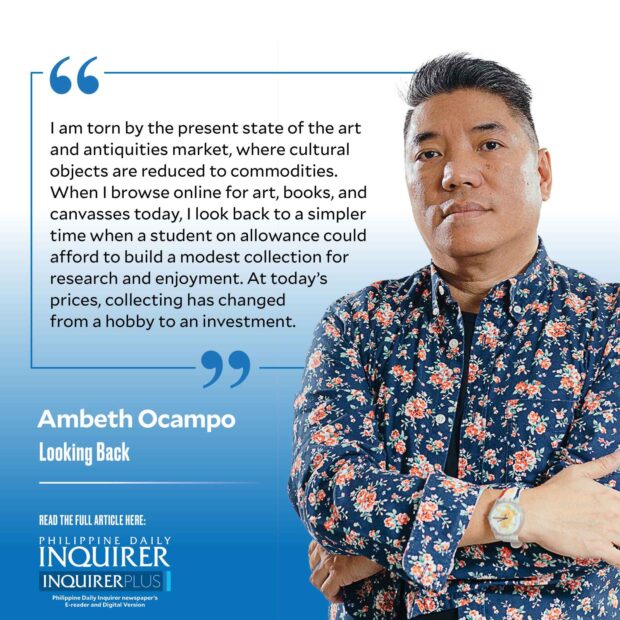‘Pawn Stars’ and ‘Pickers’
 History Channel on cable TV today is a pale shadow of its original self. In the early days of cable: History, Discovery, and National Geographic channels were a sensible alternative to the inane “entertainment” fed us by local networks. Ging Reyes of ABS-CBN News described the dire situation then as the Filipino audience being “over-entertained and under-informed.” With the decline of mainstream media and the rise of social media, the norm is virality, not information. Not even truth. To maintain ratings, History Channel has veered away from history and focused on conspiracy theories, lost worlds, aliens, and subjects your Araling Panlipunan teachers will never bring up in class even if you put a gun to their heads.
History Channel on cable TV today is a pale shadow of its original self. In the early days of cable: History, Discovery, and National Geographic channels were a sensible alternative to the inane “entertainment” fed us by local networks. Ging Reyes of ABS-CBN News described the dire situation then as the Filipino audience being “over-entertained and under-informed.” With the decline of mainstream media and the rise of social media, the norm is virality, not information. Not even truth. To maintain ratings, History Channel has veered away from history and focused on conspiracy theories, lost worlds, aliens, and subjects your Araling Panlipunan teachers will never bring up in class even if you put a gun to their heads.
Then came History reality shows: “Pawn Stars” (2009) and “The American Pickers” (2010) which had viewers scrambling for junk that could be re-appraised into a welcome financial windfall. These American shows are not original, the pioneer was “Antiques Roadshow” (1979) which crossed over from Britain to Canada and Australia before being copied for the History Channel. The plot is simple, people bring “old” stuff in and an expert gives them an appraisal that lights their eyes up like a winning slot machine. A concession to history is the explanation of its context and value. While the British show introduced viewers to things like Ming porcelain and old master paintings, the American version featured celebrity items like sporting goods used by famous athletes, or musical instruments, scores, and record jackets associated with famous entertainers or bands.
While there is no local counterpart TV, cable, or even TikTok for Filipino pickers, the closest would be the local auctions put up by León Gallery, Salcedo Auctions, Bayanihan Collectors Club, Philippine Numismatic and Antiquarian Society, and a game-changer called Carmen’s Online Auction. For bibliophiles, the most active and reliable is the pioneering Filipiñana Book Collectors Club which has spawned so many copycats including a handful of scammers. Within the group are many sellers; the best is Shoolie’s Corner who packages books so well I don’t have the heart to open them. These packages will end up as ornaments under my Christmas tree.
Filipiniana, or books on the Philippines, or by Filipinos, have increased in value over the years. A good trend for sellers, a bad one for buyers. For example, I raided the bodega of the old Librería Martínez, around the Welcome Rotonda on Quezon Avenue, and bought multiple copies of “Pastelería at repostería Francesa at Española: aclat na ganap na naglálamán ng̃ maraming palacad sa pag-gauâ ng̃ lahat ng̃ mg̃a bagay-bagay na matamis at mg̃a pasteles / ni P. R. Macosta ; isinalin sa uicang Tagalog ni Crispulo Trinidad” (Manila: Libreria Martinez, 1919). I was attracted to this book not by the recipes but by the illustrations of classic French cookery like a pyramid of cream puffs described as “Croquembucheng caraniwan.” A steal at P5 for softcover and P10 for hardcover, I regret giving them away as gifts. One or two leftovers could sell today for way more. In that bodega were piles of “Noli me tangere,” translated from the original Spanish into Tagalog by Pascual H. Poblete. First published in 1909, this edition came with crude illustrations and a valuable introduction by Saturnina Rizal, the hero’s eldest sister. How could you go wrong with a P25 hardcover?
It is hard to imagine a college student on allowance building a Filipiniana library in the 1980s, but it was indeed possible then. Every afternoon after school, I did my readings and assignments in a cozy corner of the ramshackle Heritage Art Gallery in Cubao. Afterward, I had a cheap merienda of turon, maruya, and a soft drink before heading home. I didn’t have the funds then but to give you an idea of prices, a plywood-sized painting by Ang Kiukok that would sell in the millions today could be had for P15,000, negotiable. A small prewar Fernando Amorsolo landscape had a P20,000 price tag, available on installment. Juan Luna’s last letter to his son Andres had a charming watercolor of the Hong Kong harbor on the top of the page. Price? Believe it or not, P25,000, negotiable.
With all the things I have seen in the last four decades, I can host a “Pickers” show providing historical context and leaving appraisal to art galleries, dealers, and auction houses. I am torn by the present state of the art and antiquities market, where cultural objects are reduced to commodities. When I browse online for art, books, and canvasses today, I look back to a simpler time when a student on allowance could afford to build a modest collection for research and enjoyment. At today’s prices, collecting has changed from a hobby to an investment.
—————-
Comments are welcome at aocampo@ateneo.edu




















